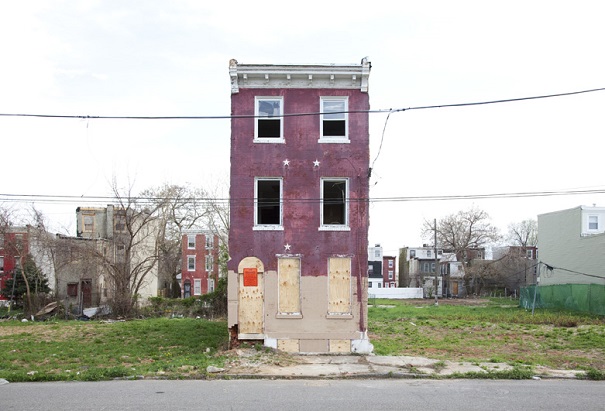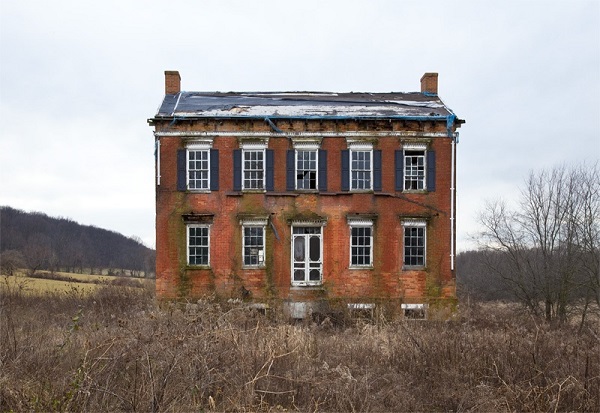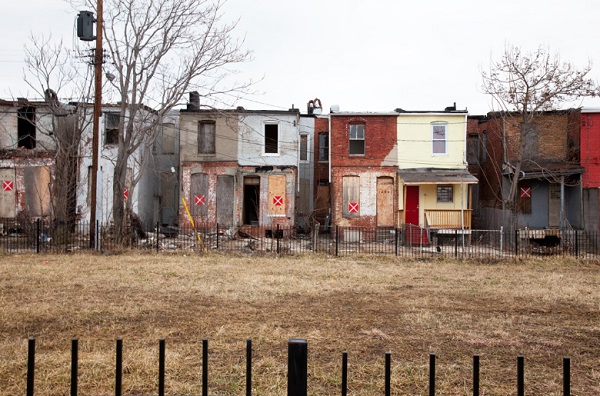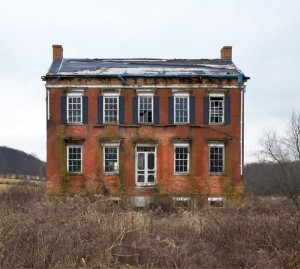Artist of the Week 11/6-11/12: A Photographer Apart: Ben Marcin Captures What Might Be the Last Documentation of Lone Structures across the North East
GALO: Apart from the varying seasons and weather conditions which must have impacted your photography during your travels for the series, did the varying colors of the buildings in Last House Standing have any significance to your theme? For example, in Last House Standing, there is a purple building in Philadelphia, PA. The purple coloring, white stars, and ornate molding create a playful appearance, which gives the building apparent warmth among the otherwise desolate background. Is there something to be said about the vibrancy of certain buildings among an otherwise lackluster backdrop?
BM: Some of the buildings are clearly in worse shape than others. These buildings were all over 100 years old; they were from the 19th century. When they were built, they were built for doctors, lawyers, and people who had money. These buildings contain 12-foot ceilings, and there is real detail. Even now that they are ruined, you can still see the original details that make up the building. They are scarred, grand houses from the 19th century that are still hanging on, and that’s what I really wanted to show. Each house is a little different, but the idea is to show that, even though they are amputees, they are still standing there kind of proud, and they still have this character from the 19th century. Houses that are built today are more modern, but they are more generic. They are kind of schlepped together, and they don’t have that much character. They don’t make houses like they used to! You can see that in the way these things are still standing there, despite all they have been through.

A photo taken of a building in Philadelphia, PA for the “Last House Standing” series by Ben Marcin. Photo Courtesy of: Ben Marcin.
GALO: Aside from focusing on the replacement of solitary homes with burgeoning consumer-based communities, A House Apart seems to demonstrate human interaction with Mother Nature, as well as what happens when humans lose control and the surrounding environment takes over. Many of the homes in the photographs seem to be swallowed up by flora, with vines consuming the walls and overgrown shrubbery covering parts of the house. What message were you trying to convey by choosing houses that are covered by their natural surroundings — does it interest you that, at one point, those homes were the focal point of someone’s life, and now they seem neglected by humans? And were you perhaps trying to insinuate that, though the houses remain empty, they still live on?
BM: Yes, absolutely. In the A House Apart series, there are all different stages of homes in there. Some homes aren’t overgrown yet; some are abandoned, but not that long ago necessarily. These folks went out here and wanted to get away from everything. You will never see anything like these houses; they are very individualistic and very independent. In this series, you can also see that many of the houses were long abandoned, and Mother Nature is sort of taking over again. Eventually, you will never see that house. That is the way the series is going. I have a couple images of homes that are just totally overgrown. You can only see a little tiny window at the very top, kind of just hanging on there [laughs].
All those photographs in A House Apart were taken on the East Coast. There are shopping malls nearby, and it is very congested here, but you still have these old houses. In the middle of all this congestion, the houses have been abandoned, and in a year or two, there might be a Walmart there. That was my idea behind this series. The jungle is sort of taking back from what [one] took from the jungle. The area surrounding the houses that are covered in vines was once completely cleared of trees. The owner must have cleared the trees and built a house there, and now the trees are coming back. Again, you wonder, where are the homeowners? Why didn’t they give it to the next generation? What happened here that somebody didn’t take the house over? The house is just left to deal with itself, just like these row houses.

A photo taken of a house in Silver Run, MD for the “A House Apart” series by Ben Marcin. Photo Courtesy of: Ben Marcin.
GALO: On Slate, it is stated that you “began using the ‘bird’s eye’ feature of Bing Maps” to look for other alike buildings. Can you tell us a bit more about this process — for instance, while using this feature, did you focus your attention on the homes that you felt were in danger of soon becoming lost forever? In other words, what other characteristics were you looking for when choosing which houses to photograph?
BM: Well, I only used Bing Maps for the row homes. They are in very bad neighborhoods; they are in the ghetto, where there is a lot of crime. So, each of the row houses you see in my series was attached, with 10 on each side. But in the last 20 to 30 years with the drug wars, gang battles, gun wars, and things like that in areas like Philadelphia, D.C., and Baltimore, crime increased tremendously, so people left. When people left their row homes, drug lords would take over. Eventually, cities would come in and tear down an entire block, but every now and then, they leave one house standing. This is the reason why I got involved with these row houses. Why did they do that? Why did they choose to leave one house standing?
In one case, I thought a house was abandoned, and a man in jeans and a bathrobe came out and walked right up to me and said, “Hey, boy, you from the city? You going to tear my house down?” He was very uptight about me standing in front of his house taking a photograph, and he was wondering what was going to happen to his house. It was at that point that I understood he probably raised a stink and fought back against the city. The city wasn’t going to knock down this guy’s home. This is what interested me in doing these row houses. So, getting back to the Bing Maps, I used them to get in about 300 feet in the sky, and you could see where the row houses are. What was interesting about that was the maps were one to three years old. So I would show up and the solo house might be gone, but now another block that looked like a nice neighborhood on the map only has one house left on it. I used the maps to dive in and find the really bad neighborhoods. Once I found those “pumpkin teeth” on the satellite maps, I figured my odds were good in actually finding some of these homes.
I did not use the Bing Maps on my A House Apart series. I found these houses through hikes I went on. The houses would be sitting there in the middle of the forest.

“Baltimore Rowhouses” by Ben Marcin. Photo Courtesy of: Ben Marcin.
GALO: You state on your Web site that your attraction to older buildings stems from their “ghostly beauty” and “their odd placement in the urban landscape.” The isolated buildings in Last House Standing were once part of a larger structure; however, over time, only a single building is left standing. Was your interest in photographing these remaining structures due to a sense of urgency in capturing the remnants of a structure that may soon be completely lost to time? Do you find a sense of purpose as an artist that, through your work, an image of these buildings will last indefinitely?
BM: Yes, absolutely. It is a historical document. In fact, here in Baltimore, they announced that, this year, they are going to tear down the remaining row homes. They are going to build community garden plots, and they decided that it was better for the neighborhood if they just tear down what’s left. They are going to use eminent domain, where a large government will come in and say for the better good of society, “We are going to tear your house down so we can build this airport here.” Stuff like that. Otherwise, people would just hold out. Well, these are holdouts. These folks stayed in those houses during the worst of the drug wars. Everybody left — they left for the suburbs and better opportunities elsewhere. They were afraid, but these people stayed. When that happens, I am going to go back and reshoot the space. Forty years ago, these houses were doing great, and now, under the demographic and social changes, the homes couldn’t take it. The houses could not take people; they couldn’t take social changes like that!
(Interview continued on next page)

